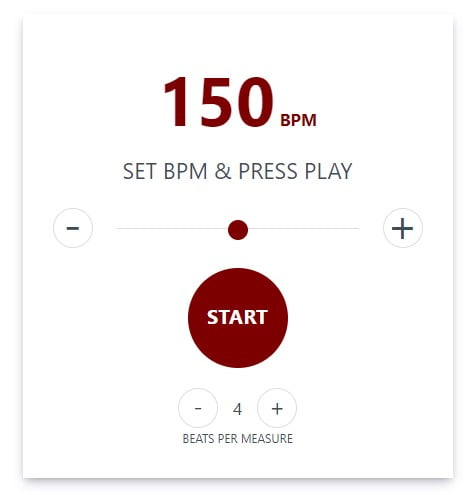Want to supercharge your guitar progress? Having a solid practice routine is key. But it's not just about putting in the hours - it's about practicing smart.
I've been teaching guitar for over 20 years, and I've seen firsthand how the right practice habits can skyrocket a student's skills. On the flip side, I've also seen players spin their wheels for years without making much headway before asking for help from me.
The difference?
A well-structured, focused practice schedule that maximizes results.
And that's exactly what I'll talk about today. I'm going to share with you the same guitar practice routine I recommend to my beginner-intermediate students. This simple yet powerful schedule will help you:
Adopting this routine has been a game changer for many of my students, I advise that you read it carefully so you understand the details behind how it works. Warning: there is some science involved 😉
Daily Guitar Practice Schedule (40-80 minutes per day)
My method of teaching revolves around learning through playing popular songs. Not just any song of course, but the ones chosen by skill level and technique variance to develop the student.
| Section | Duration | Details |
|---|---|---|
| 1. Warm-up and technique exercises | 5 minutes | - Finger stretches - Chromatic scale or simple finger independence exercises |
| 2. Scales and arpeggios related to current song | 10-15 minutes | - Major scale, minor pentatonic scale, major and minor arpeggios - Practice with a metronome, increasing speed gradually |
| 3. Song practice | 15-30 minutes | - Work on 1-2 sections of a new song - Review sections of songs you already know - Practice with a metronome or backing track |
| 4. Music theory of current song | 5-10 minutes | - Review concepts found in the current song (e.g. chord progressions, entire scales) - Practice the theory in isolation |
| 5. Free play | 5-20 minutes | - Use a looper pedal or jam track to play the things you learned in a new way |
This table breaks down each section of the practice routine with clear time allocations and specific action items.
Here are some things you should note:
- I like to keep the warm-up short and sweet, focusing on exercises that limber up the fingers and get the hands synced up. Things like chromatic scales and finger independence drills work great.
- Scales and arpeggios are the building blocks of music, so it's crucial to practice them in the context of your current song. This helps connect theory with real-world playing.
- The bulk of the routine goes to song practice. I'm a big believer in learning complete songs, as it's the most natural way to apply techniques and stay motivated. Aim to work on just a couple sections at a time to keep things focused.
- Finally, a small block for music theory helps solidify concepts like chord progressions and scale patterns. It's important to learn the underlying theory behind what you are playing, so for example, if a song uses a solo or riff from the G minor pentatonic scale, you need to learn the entire scale and intervals, not just the riff.
- The key is to consistently hit each of these elements on every day of practice in a structured way.
How often should you practice?
I've found that the sweet spot for most of my students is to aim for 2 consecutive days of focused practice, followed by a rest day.
So for example, you might practice for an hour on Monday and Tuesday, take Wednesday off, then practice again on Thursday and Friday, and so on.
I did some reading up on why this might be, and I think this approach works so well because it balances the need for consistent practice with the importance of rest and recovery on a neurological level.
- When you practice two days in a row, you reinforce the neural pathways and muscle memory you're developing in each session.
- But then, by taking a rest day on the third day, you're allowing your brain and body to consolidate those gains. Your brain needs that downtime to process and integrate all the new information and skills you've been working on.
- Plus, taking a rest day helps prevent burnout and keeps you fresh and motivated. You don't want your practice sessions to feel like a chore.
On your rest days, it's still okay to noodle around on the guitar a bit if you want. Just keep it light and playful - more jamming and exploring than serious practice. The main thing is to give your brain and body a break from the focused, deliberate practice that you're doing on your "on" days.
I also like to do more reading on my off days than usual. You can get web fiction for free, or buy normal books from Amazon books or Barnes and Noble.
Now, this 2-on-1-off schedule is just a guideline, not a hard and fast rule, but I think you'll find that it's a sustainable and effective way to make steady progress on the guitar without burning yourself out. Obviously, the more you play the better, so if you're on a roll, don't let me stop you from practicing every single day 🙂
By the way, you should check out my article on how long it takes to learn guitar.
Understanding The Schedule
My proposed practice routine is different than what you will see on other sites. For example, Justinguitar recommends a linear approach for beginners and a self-directed one for intermediates, while the Musician's Insitute leans towards focusing on techniques. Other sites recommend an A, B, C day split.
My song-based practice routine revolves around what music is about, learning to play songs.
I believe that learning songs you love and connect with is what keeps students motivated to continue learning and advancing. Plus, it is a natural way to learn new techniques, theory, and the whole shebang.
So to understand the "Why?" and give you some extra pointers you should integrate into your sessions, please read the below points well, don't just skim.
1. Consistency is key
Following the same practice schedule every day is crucial for building good habits and seeing steady progress. It's like going to the gym - you won't see results if you only go once in a while, but if those daily reps add up, you'll reach your goals sooner rather than later. Consistent, focused practice of new material is what leads to real improvement.
Consistency and repetition trains your brain and fingers to work together efficiently. Over time, complex techniques will start to feel more natural and automatic.
2. Always practice with a goal in mind
Having a clear objective, not just for each practice session, but also for each part of the session, is essential for making tangible progress.
And I ask you, what better goal than learning a new song? They give your practice sessions purpose and direction. They're the reason we all picked up the guitar in the first place. And to look cool 😉
Practicing with a specific song in mind helps you apply techniques in a musical context. You're not just learning isolated licks or patterns - you're seeing how they fit into real music. This makes your practice more engaging and rewarding.
If you're self-taught or are learning from a guitar lesson site, you'll need to put in the extra effort to look up the theory each song includes. But if you have a teacher or use the song lessons on TheGuitarLesson.com, it is easier.
3. Don't rush past the fundamentals
Getting the basics down solid - like good technique, clean notes, and smooth chord changes - is super important. I've seen a lot of students want to skip ahead to the flashy stuff, but trust me, having strong fundamentals prevents a ton of issues down the road.
When you're working on tricky basics, try using "spaced repetition". That just means coming back to a problem area frequently but with breaks in between. Like if you're struggling with a chord change, drill it for a few minutes, work on something else, then come back to it. Rinse and repeat. It works way better than trying to force it.
4. Isolate difficult sections
When tackling a new song, zoom in on the challenging parts and work on them in isolation. This laser-focused approach helps you conquer tricky techniques much faster.
By breaking songs down into manageable chunks, you're setting yourself up for success since you can drill down on problem areas without getting overwhelmed. And as you piece the sections together, you'll see (hear) the song taking shape.
Remember to practice challenging things slowly at first, and speed up as you can. Metronomes are great for this.
5. Use a metronome
Practicing with a metronome is hands down one of the best ways to tighten up your timing and develop a strong internal pulse. It might feel awkward at first, but trust me - it's worth pushing through that initial discomfort.
I used to not even accept private students if they didn't get a metronome, but now you can simply use our online metronome.
Start slow and gradually bump up the tempo as you get comfortable with whatever you are working on. It helps you progress while playing in time, albeit at a slower pace at first.
It's also what separates the amateurs from the pros, and is essential for later on when you start jamming with others. You'll be able to lock in with other musicians and groove out, instead of them looking at you when you are half-beat off rhythm 15 seconds into a session...
6. Record yourself periodically
Regularly recording your playing is a powerful way to track your progress, analyze your clean playing, timing, dynamics, etc., and identify areas for improvement. It's easy to get caught up in the moment while practicing, but watching or listening back to a recording later gives you an objective perspective on how you played.
It helps you develop critical listening skills, and you'll train your ear to pick up on the subtle details in your playing, like timing and phrasing. This heightened awareness will carry over to your practice sessions, making you more mindful and efficient, since you'll know what you need to work on.
You will be surprised by what you hear, I still am to this day 😀
7. Minimize unnecessary finger movements
If you want to play faster and cleaner without working as hard, you gotta be efficient with your movements. So take a look at your fretting and picking hands in your recordings.
- Are your fingers flying away from the fretboard when changing chords?
- Are you using big, swooping strokes when strumming?
Try to keep your fingers close to the fretboard and use small, tight picking motions. It might feel weird at first, but trust me, cutting out the extra movement will help your playing big time.
8. Study the underlying music theory
Taking a few minutes each day to study guitar music theory can do wonders for your overall understanding of the guitar. Don't just memorize finger patterns - dig into the "why" behind the notes and chords you're playing. This knowledge will help you learn songs faster and might even kickstart your songwriting in the future.
Theory is rather dry for most people by itself, but it doesn't have to be. With the routine I proposed, you learn theory by learning the theoretical concepts in the songs you're working on. So things like chord progressions, keys, scales, and song structure. Seeing theory in action makes it much more approachable, relevant, and dare I say interesting as well.
9. Take breaks as needed, or split up the session
It's important to push yourself during practice, but it's equally important to know when to take a breather. If you find your mind wandering or your fingers starting to ache, it is time for a short break. Get up, stretch, hydrate, whatever.
Stepping away for even a minute will help you recharge and refocus. And if you still find your mind wandering, take a longer break and come back in an hour. Several short, focused sessions are way more productive than one long, unfocused session.
10. Hurray for small victories
Learning guitar is a journey, and it's important to celebrate the milestones along the way.
- Did you nail that tricky chord transition?
- Bump up your metronome speed?
- Learn your first full song?
Congrats, you should feel great about it! Those are all wins worth savoring and even showing off to a friend or family member. This becomes extra important if you don't have a private teacher to pat you on the back.
Truly acknowledging your progress in a mindful way, no matter how small, helps you stay positive and motivated.
11. Practice standing up sometimes
I know, practicing on the couch is comfortable. But you gotta mix in some standing practice too.
Why?
Because when you start jamming with buddies later on, you'll be on your feet. It feels way different to play standing, so it requires practice as well. Your future self will thank you, trust me.
12. Consider getting a looper pedal
If you really want to take your guitar playing to the next level, I highly recommend picking up a looper pedal. This applies mostly to electric guitar players, but if you have an acoustic-electric and an amp, go for it.
A looper lets you record yourself playing a chord progression and then plays it back in a continuous loop. You can then play over top of that loop, adding more layers of riffs, percussive rhythmic bits, or anything. It's a lot of fun when you get into it and have the ability to create an entire song made of your looped layers.
Loopers also force you to play in time and really lock into a groove.
We didn't have looper pedals when I was young, boy, did we miss out.
13. Accept that some days you just can't practice
Hey, life happens. I've had plenty of times where work or family stuff meant my guitar didn't get touched for a bit. I have 2 kids and a Maltipoo named Maverick...

But that's okay. A big mindful OK, if you get what I'm saying 😉
If you miss a few days, don't sweat it. Your love for playing will bring you back to the guitar when things settle down. In the long run, a little time off here and there isn't gonna derail you. Try to keep your practice sessions going, and just roll with it.
Follow a structured learning program
There's a ton of guitar info out there and it's easy to get overwhelmed, especially if you're used to browsing the millions of YouTube guitar lessons. That's why I'm a big fan of following a structured program, whether it's a well-reviewed online course or working with a good teacher.
A solid program will have:
- A step-by-step plan to build your skills.
- No more guessing what to practice next.
- Plus, you'll get feedback to keep you on the right track.
Here are the 2 online sites I know of that integrate learning songs into the curriculum.


